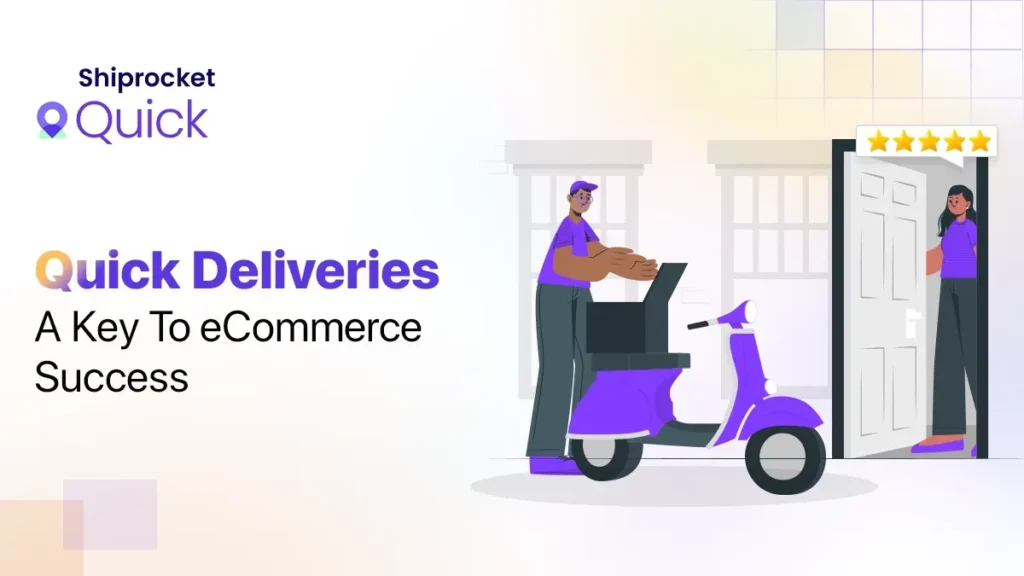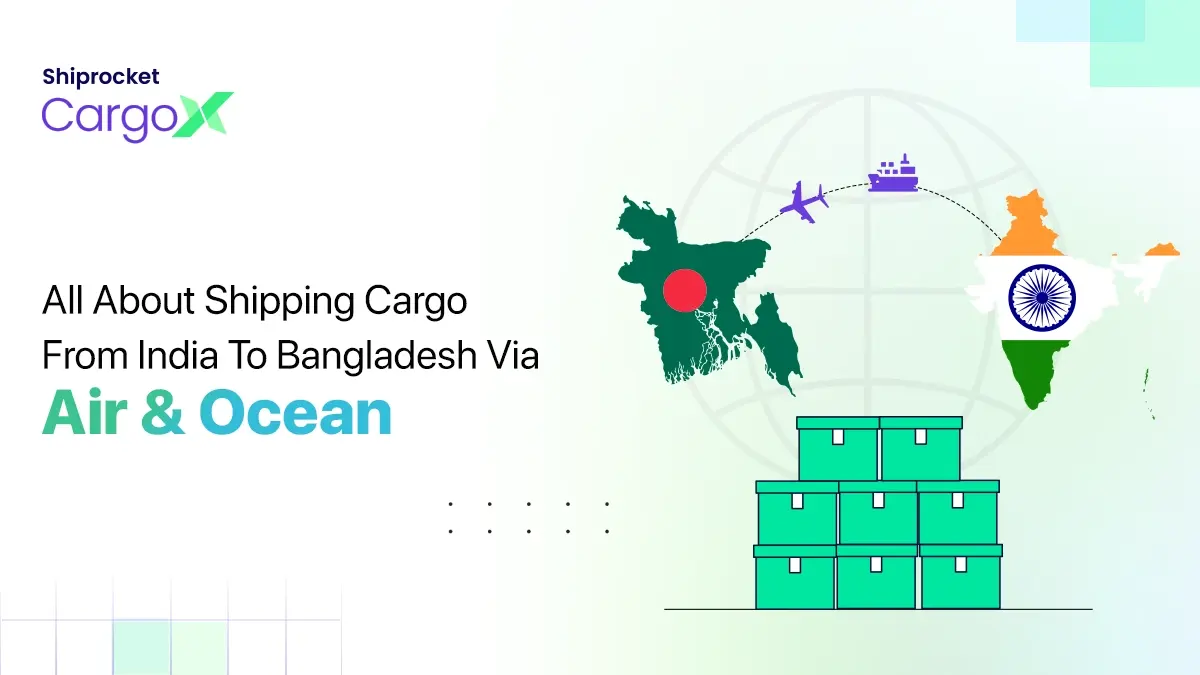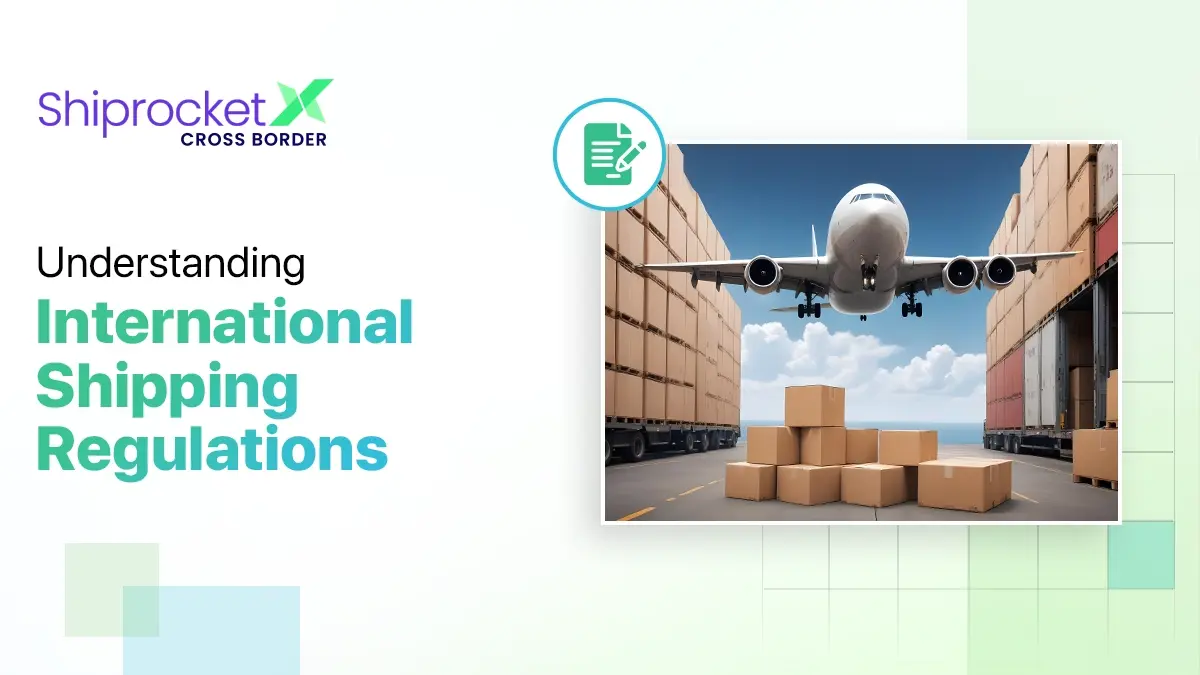Quick Delivery Services Pioneering the Way Forward for eCommerce
- What is Quick Delivery Service?
- How is it Different from Traditional Delivery Services?
- How Does Quick Delivery Service Work?
- Operational Challenges Facing Quick Delivery Service
- Why Optimisation Matters in Quick Delivery Service
- Quick Delivery Service: Recent Trends Reshaping the Landscape
- How Businesses Can Offer Quick Delivery Service
- Why is Shiprocket Quick the Best Choice for Quick Delivery Service
- Conclusion
The market size for quick delivery commerce was valued at USD 92.88 billion in 2019 and is expected to grow from USD 106.89 billion in 2023 to USD 291.17 billion by 2031. It’s expected to grow at a CAGR of 13.10% between 2024 and 2031. The demand for quick delivery services has skyrocketed. Customers expect their orders to arrive swiftly and reliably, whether it’s eCommerce packages, groceries, or meals. The evolution of logistics technology and innovative delivery models has significantly transformed how businesses operate, focusing on efficiency and customer satisfaction. Quick delivery services are not just a convenience but a necessity in the market. They help businesses retain customers, meet rising expectations, and differentiate themselves from competitors. This shift has led to implementing advanced solutions like real-time tracking, automated dispatching, and route optimisation, ensuring that products reach customers promptly and accurately.
This blog will explore quick delivery services, including how they work, how businesses can offer customers quick deliveries, and more.

What is Quick Delivery Service?
Speedy delivery options are a major requirement today and several surveys show that about 46% of the surveyed number abandoned their carts due to long delivery periods.
Quicker and more efficient order completion processes indicate the success of any business.
Quick delivery is undergoing extensive research and development while being subjected to innovative and creative solutions. This helps corporate giants update their strategies to meet the growing needs and demands. Walmart and Amazon are two major examples of this. Prime delivery offers Amazon customers several benefits and Walmart gives their buyers next-day deliveries without any added charges.
Studies also show that customers expect these quick delivery services to be free. When companies provide excellent customer service through fast delivery and reverse logistics processes, they can experience larger volumes of sales, a reduction in cart abandonment rates, and enhanced consumer loyalty.
How is it Different from Traditional Delivery Services?
The transformation of the digital world, combined with the efforts of other creative and innovative solutions, has allowed businesses to execute same-day and next-day deliveries effortlessly. Several eCommerce companies, however, still follow the traditional methods of 3-5-day deliveries. It results in longer order fulfillment times.
Modern models like the quick delivery model ship the parcel immediately upon order placement. This extremely versatile model offers several variants like 10-minute, 30-minute, next-day, and same-day delivery. It shows that the complete process from receiving the order, bagging, routing, and delivery happens within a short span.
How Does Quick Delivery Service Work?
Fast delivery options can fulfil their order within minutes. Streamlined solutions can handle large order volumes through agile, cost-effective, and consumer-oriented operations. Listed below are a bunch of steps involved in a seamless and efficient on-demand delivery experience:
- Step 1: A buyer places an order and the delivery handling system has received an intimation of the details and SLA from OMS/WMS/ERP, etc.
- Step 2: The delivery management system’s auto-order allocation engine will then delegate orders based on the type after considering different optimisation constraints. It then pushes them on the driver application for execution. It is all done through AI and ML innovative solutions that enhance efficiency and gains.
- Step 3: When the rider is notified, the order is collected from the vendor and the delivery process begins. The drivers present in that specific area will be subjected to an evaluation and will be assigned to complete the delivery process.
- Step 4: The driver application comes in handy for tracking purposes, as the driver’s real-time details with the delivery management system will push notifications of orders and vehicles to the right parties. Route optimisation is also done through this platform.
- Step 5: Another notification is pushed when the delivery partners complete the doorstep deliveries and collect the cash on delivery or online payments. It confirms the completion of the order to all the concerned stakeholders.
- Step 6: The system then gives you the analytics relevant to delivery time, mode of payment, and causes of late deliveries.
Operational Challenges Facing Quick Delivery Service
The operational challenges in quick delivery service include the following:
- Accuracy of the address or delivery location: The address entered by the customer can lack accuracy, creating confusion that eventually leads to delayed deliveries. It can also cause failed and wrong deliveries.
- Lack of efficiency in operations: For same-day and quick commerce deliveries, your driver must always be available to meet the demands and strict delivery timelines. Without automation, keeping track of and allocating resources based on key factors like cost-effectiveness, location, and nearest available delivery agent becomes challenging.
- Lack of automation for handling stakeholders: The manual delivery systems cannot be seamlessly integrated with other systems like OMS, ERP, WMS, etc. The struggle with on-time pick-up and delivery, order allocation, and tracking will become extremely challenging without AI.
- Dynamic market trends: The demand for a specific product is never linear. Seasonal demands for certain products during rush hour, sales, and festivals are often experienced. Without smart platforms, understanding these trends and planning inventory can become challenging. Brand reputation and revenue can take a hit with improper management.
- Smaller delivery windows: Quick deliveries must be fulfilled within 30 minutes or less. Manual or conventional systems will fail to meet the urgency of these tight schedules. Mismanagement of goods and inefficiency can bring down gains.
- Improper optimisation of vehicle use: When the delivery management system is not organised well, the maximum potential of your quick delivery services cannot be attained. Without the involvement of automation, optimisation of routes, planning multi-stop deliveries, and achieving vehicle efficiency can be tedious.
Why Optimisation Matters in Quick Delivery Service
Here’s a list of the reasons why optimisation in quick delivery service matters:
- Streamlining route-planning and travel: A company that sells food, grocery, bakery, pharmaceuticals, etc., must be able to deliver their products as quickly as possible. Dynamic routing must be used to make sure that the delivery flow is uninterrupted despite any external factors. AI helps with this and enables fulfillment irrespective of external factors.
- Order Management: The primary goal of order management is successfully executing a specific order. Efficient tracking, capturing, fulfilling, and handling customer orders are different variables of a management process. A proper delivery management system tracks and auto-allocates orders based on consumer specs, location, etc.
- 3PL Management: The overhead costs can be largely reduced when you employ a 3PL platform management partner. They also give you options like scalability that save you large amounts of time. However, managing different 3PLs is essential for efficient and profitable operations.
- Order clubbing: Profitability can be achieved when you club different orders together. The total cost of ownership (TCO) is also minimised largely. Optimising your routes and joining forces with different orders can allow you to complete your orders and do it with a lower carbon footprint and labour.
Quick Delivery Service: Recent Trends Reshaping the Landscape
Here are some recent trends that are reshaping and transforming the quick delivery landscape:
- Using AI and ML in delivery management: Futuristic technologies and data analytics play crucial roles in the supply chain and disruption of logistics. One such example is using historical data to understand patterns, identify gaps, and enhance delivery operations.
- Automatic order allocation to meet the demand: If you are a brand that sells perishables products or items that need to meet their fulfillment targets as quickly as possible, you will need a robust and efficient solution to map out the routing.
- Dark storage facilities: With the establishment of dark storage facilities, the cost of infrastructure will largely decline. Businesses will try to minimise delivery times and focus on hyper-local markets. Online orders can continue and fulfillment can occur through delivery partners placed strategically across these stores.
- Subscriptions: Discounts, coupons, cashback, etc., are aggressive approaches businesses adopt to attract more buyers. The retail store management costs are minimised through dark stores. Brands can use more of their funds to provide lucrative deals to their customers, thereby enhancing loyalty.
- Automation in delivery driver management: Safety of the drivers is critical in quick delivery models. Businesses must invest largely to create robust solutions that facilitate safety, route optimisation, and easy rider payouts.
How Businesses Can Offer Quick Delivery Service
When companies make their platforms, they must consider the future trends and their application’s ability to adapt to futuristic technologies. Listed below are a couple of ways to reshape this landscape:
- Integrated automation: Automation eliminates redundancy and also looks for loopholes. It will help businesses excel at their operations capabilities. Hence, investing in smart automation significantly helps businesses.
- Selecting the right SaaS platform: A standalone software can be rather pricey. Moreover, it can fail to give you ad-hoc reports, and it will need IT dependence. The cloud-based data will be stored securely and safely through customised SaaS software. It can also be shared without any major trouble. Managing these platforms is simpler and you can use them to gain insights quickly. Analytics and metrics on missed and delayed deliveries, milestones, etc., can allow the necessary partners to identify gaps and bridge them.
Why is Shiprocket Quick the Best Choice for Quick Delivery Service
Shiprocket Quick aims to bridge the gap between small and medium businesses in remote locations and their customers. It’ll equip them with a technology stack to reach and sell to their target audience in country’s remotest areas. Shiprocket Quick is a cost-effective solution, offering faster rider allocation, live order tracking, and multiple carrier options for local courier service. Backed by Shiprocket, it offers exclusive rates for D2C traders. Moreover, Shiprocket Quick is an all-in-one platform, with integrations for major courier partners, including Dunzo, Porter, etc., in a single place.
Conclusion
Quick delivery services have become a cornerstone of modern commerce, shaping customer expectations and business strategies. The logistics and shipping industries will continue to evolve; thus, businesses must adapt by leveraging technology and innovative practices to maintain high levels of efficiency and customer satisfaction. The future of delivery services lies in continuous improvement and responsiveness to customer needs, ensuring that the promise of speed and reliability is consistently met. Businesses must focus on these aspects. It will help them meet and exceed customer expectations, fostering loyalty and driving growth in a competitive marketplace. Adapting to these advancements will ensure that companies stay ahead in an era where quick delivery is no longer a luxury but a fundamental requirement.






